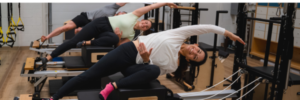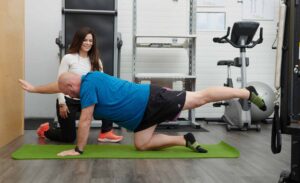When we think about relieving tight muscles, we may think about doing some nice, easy stretches to help us move better. But, we often forget about a very important component to our muscles functional health, our fascia! Fascia is our body’s connective tissue. It’s like a spider web running head-to-toe, inside-to-out, that is a stabilizing, enclosing, interwoven system of fibrous connective tissue found throughout the body.
When our fascia becomes unhealthy, it gets sticky, tight, and clumpy, which causes those nice, connective sheets to form restrictions, become distorted, and that’s when we start to feel knots in our muscles. Unhealthy fascia can also lead to muffled or muted signals from the nerve endings, which means that our muscles start to feel uncomfortable when they do work and the signals can get interpreted by our brain incorrectly as pain and discomfort.
That being said, there are many ways we can improve our fascia health, such as myofascial release. An example of this is foam rolling, which is a great tool to help pin point where our fascia is full of tension and restrictions.
HOW DOES FOAM ROLLING IMPROVE YOUR FASCIA HEALTH?
Foam rolling is simply applying low-intensity forces over a period of time. But, by doing so, this technique helps:
- Increase blood flow to areas and bring in nutrients like oxygen and glycogen to muscles
- Improve range of motion and create smoother muscle movements
- Speed up recovery and decrease post-workout soreness (DOMS)
- Stimulate nerve receptors and causes the “releasing effect”; reducing pain signals in those areas
- Reduce your risk of injury
HOW CAN YOU REAP THE BENEFITS OF FOAM ROLLING?
The best way is to incorporate myofascial techniques such as foam rolling and roll regularly! Try to adhere to a daily rolling routine like Katrina’s Fascia Fiesta below! After all, just like exercise, you have to be consistent to get the best results!
To browse our selection of foam rollers click here!
WHEN SHOULD YOU FOAM ROLL?
Aim to foam roll before and after workouts, or anytime you feel tight. Stick to your muscles, rather than rolling your ligaments or joints. Try to target all your major muscle groups and aim for at least 1 minute targeting a specific area. Remember, doing one push up isn’t going to give you abs, so foam rolling once is not going to give you healthier fascia.
To summarize, foam rolling is a great and easy tool you can add into your daily routine to help you Move Well, Be Well. So, grab a foam roller and start rolling your way to healthier fascia now!
TIP: NEW TO FOAM ROLLING?
Try Katrina’s 10 Minute Fascia Fiesta targeting the calves, hamstrings, glutes, back, quads, and cervical areas!
References
Pearcey GE, Bradbury-Squires DJ, Kawamoto JE, et al. Foam rolling for delayed-onset muscle soreness and recovery of dynamic performance measures. J Athl Train. 2015.
MacDonald GZ, Penney MD, Mullaley ME, et al. An acute bout of self-myofascial release increases range of motion without a subsequent decrease in muscle activation or force. J Strength Cond Res. 2013.




